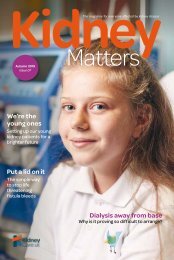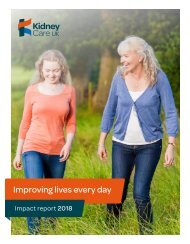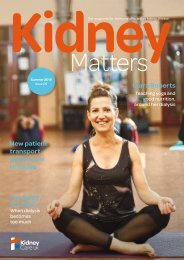Kidney Matters - Issue 15 Winter 2021
Kidney Matters is our free quarterly magazine for everyone affected by kidney disease. This issue includes features on learning to accept and embrace changes to your body, celebrating black kidney donors throughout Black History Month, fluid management, diabetes after transplantation, and an article all about how a young working mother of two children coped with her CKD diagnosis. As well as this, the Kidney Kitchen features a delicious, low potassium Christmas pudding! We know that being a kidney patient can be tough at times and that accessing the right help at the right time isn’t always easy. We’ve spent a great deal of time over the past year talking to kidney patients on dialysis, asking them what we can do to address this. The response was overwhelmingly ‘improved communication’ on what is going on in the kidney world and what is available to them in terms of support and how to access it. Kidney Matters has been developed to tackle this as well as the many other issues kidney patients face in day-to-day life. Along with shared patient experiences, Kidney Matters provides information on how to access emotional and practical support, financial assistance through our grant schemes, advice from leading kidney specialists and tips on how to keep as well as possible by eating a healthy diet whilst on dialysis.
Kidney Matters is our free quarterly magazine for everyone affected by kidney disease.
This issue includes features on learning to accept and embrace changes to your body, celebrating black kidney donors throughout Black History Month, fluid management, diabetes after transplantation, and an article all about how a young working mother of two children coped with her CKD diagnosis.
As well as this, the Kidney Kitchen features a delicious, low potassium Christmas pudding!
We know that being a kidney patient can be tough at times and that accessing the right help at the right time isn’t always easy. We’ve spent a great deal of time over the past year talking to kidney patients on dialysis, asking them what we can do to address this. The response was overwhelmingly ‘improved communication’ on what is going on in the kidney world and what is available to them in terms of support and how to access it.
Kidney Matters has been developed to tackle this as well as the many other issues kidney patients face in day-to-day life. Along with shared patient experiences, Kidney Matters provides information on how to access emotional and practical support, financial assistance through our grant schemes, advice from leading kidney specialists and tips on how to keep as well as possible by eating a healthy diet whilst on dialysis.
Create successful ePaper yourself
Turn your PDF publications into a flip-book with our unique Google optimized e-Paper software.
36
How much do HD patients know
about fluid management?
Decisions about how much fluid is removed during haemodialysis (HD) are made at every
treatment session. However, it is not clear how involved patients are in these decisions,
nor are their understanding and experiences of their fluid management during dialysis well
understood. Researchers from Leeds decided to find out.
Healthy kidneys control the balance between fluids
taken in and excreted in the urine. When kidneys are
not working properly, the extra fluid is retained in the
body. This is why fluid management is so critical for
dialysis patients, and why it is essential to agree and
regularly reassess your target weight (also known as
dry weight or ideal weight).
Your target weight is a compromise between your
having symptoms from removing too much fluid
during dialysis and leaving too much fluid in your
body between dialysis treatments, and it is used as
a target at each dialysis treatment. If target weight is
too high and not enough fluid is removed, you will have
symptoms of fluid overload. These include swollen
tissues (oedema), breathlessness due to fluid on the
lungs, raised blood pressure (hypertension), and in
the long term enlargement of the heart and heart
failure. Conversely, if target weight is too low and too
much fluid is removed, you may suffer from thirst,
dry mouth, cramping, nausea, low blood pressure
(hypotension) and fatigue (feeling ‘washed out’). You
may also find that you produce less urine, and there is
also a risk of fistula failure.
Key findings from the study
• People dialysing in centre (in hospital or in
a satellite unit) feel in control of their fluid
management—for example, being able to
influence how much fluid is removed during
dialysis—but their knowledge and willingness to
report fluid-related symptoms are limited
• Home HD patients feel more in control of and are
more knowledgeable about fluid management
and are more willing to achieve their target
weight, but gaps in their knowledge remain
• HD patients would benefit from more
information and educational opportunities
to help them better understand decisions
about target weight in the hope that this could
improve their fluid management and support
them in shared decision making with staff.
To find out how much HD patients understand about
decisions on fluid management, the researchers
surveyed people dialysing at home and in centre
(people dialysing in hospital or a satellite unit), across
11 NHS Trusts. The survey was completed by 1,189
in-centre patients and 99 home dialysis patients. The
patients answered questions about fluid removal,
symptoms, decision making, staffs’ understanding,
and target weight.
“Symptoms best
understood were
cramping, drop in blood
pressure and swelling“
www.kidneycareuk.org

















